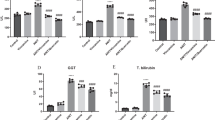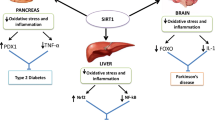Abstract
Approximately 70–90% of mushroom poisoning deaths are caused by α-amanitin-induced liver injury resulting from RNA polymerase II (RNAP II) inhibition. Liver regeneration ability may contribute greatly to individual survival after α-amanitin poisoning. However, it is unclear what cellular pathways are activated to stimulate regeneration. We conducted dose–effect and time–effect studies in mice that were intraperitoneally injected with 0.33–0.66 mg/kg α-amanitin to establish a poisoning model. The liver/body weight ratio, serological indices, and pathology were evaluated to characterize the liver injury. In the time–effect study, the liver transcriptome was analyzed to explore the mRNA changes resulting from RNAP II inhibition and the underlying pathways associated with recovery. Based on the two animal studies, we established a poisoning model with three sequential liver states: early injury, regulation, and recovery. The mRNA changes reflected by the differentially expressed genes (DEGs) in the transcriptome could be used to illustrate the inhibition of RNAP II by α-amanitin. DEGs at four key time points were well matched with the three liver states, including 8-h downregulated genes in the early injury state, 16-h and 72-h upregulated genes in the regulation state, and 96-h upregulated/downregulated genes in the recovery state. By clustering analysis, the mTOR signaling pathway was screened out as the most promising potential pathway promoting recovery. The results of our investigations of the pathways and events downstream of the mTOR pathway indicated that the activation of mTOR probably contributes crucially to liver regeneration, which could be a promising basis for drug development.






Similar content being viewed by others
References
Ali Y, Shams T, Wang K et al (2020) The involvement of human organic anion transporting polypeptides (OATPs) in drug-herb/food interactions. Chin Med 15:71. https://doi.org/10.1186/s13020-020-00351-9
Brueckner F, Cramer P (2008) Structural basis of transcription inhibition by alpha-amanitin and implications for RNA polymerase II translocation. Nat Struct Mol Biol 15(8):811–818. https://doi.org/10.1038/nsmb.1458
Bushnell D, Cramer P, Kornberg RD (2002) Structural basis of transcription: alpha-amanitin-RNA polymerase II cocrystal at 2.8 A resolution. Proc Natl AcadSci USA 99(3):1218–1222. https://doi.org/10.1073/pnas.251664698
Chen ZH, Zhang P, Zhang ZG (2014) Investigation and analysis of 102 mushroom poisoning cases in southern China from 1994–2012. Fungal Divers 61(1):123–131. https://doi.org/10.1007/s13225-013-0260-7
Chen X, Shao B, Yu C et al (2020) The cyclopeptide-amatoxin induced hepatic injury via the mitochondrial apoptotic pathway associated with oxidative stress. Peptides 129:170314. https://doi.org/10.1016/j.peptides.2020.170314
Faulstich H (1979) New aspects of amanita poisoning. Klin Wochenschr 57(21):1143–1152. https://doi.org/10.1007/BF01491754
Fiume L, Stirpe F (1966) Decreased RNA content in mouse liver nuclei after intoxication with alpha-amanitin. Biochim Biophys Acta 123(3):643–645. https://doi.org/10.1016/0005-2787(66)90239-5
Fiume L, Wieland T (1970) Amanitins. Chemistry and action. FEBS Lett 8(1):1–5. https://doi.org/10.1016/0014-5793(70)80210-1
Fiume L, Marinozzi V, Nardi F (1969) The effects of amanitin poisoning on mouse kidney. Br Exp Pathol 50(3):270–276
Garcia J, Costa VM, Carvalho A (2015a) Amanita phalloides poisoning: mechanisms of toxicity and treatment. Food Chem Toxicol 86:41–55. https://doi.org/10.1016/j.fct.2015.09.008
Garcia J, Costa VM, Carvalho AT et al (2015b) A breakthrough on Amanita phalloides poisoning: an effective antidotal effect by polymyxin B. Arch Toxicol 89:2305–2323. https://doi.org/10.1007/s00204-015-1582-x
Garcia J, Costa VM, Bovolini A et al (2019) An effective antidotal combination of polymyxin B and methylprednisolone for α-amanitin intoxication. Arch Toxicol 93(5):1449–1463. https://doi.org/10.1007/s00204-019-02426-5
Gnatt AL, Cramer P, Fu J, Bushnell DA, Kornberg RD (2001) Structural basis of transcription: an RNA polymerase II elongation complex at 3.3 A resolution. Science 292(5523):1876–1882. https://doi.org/10.1126/science.1059495
Guhaniyogi J, Brewer G (2001) Regulation of mRNA stability in mammalian cells. Gene 265(1–2):11–23. https://doi.org/10.1016/s0378-1119(01)00350-x
He JB, Chen JY, Wei XY et al (2019) Mammalian target of rapamycin complex 1 signaling is required for the dedifferentiation from biliary cell to bipotential progenitor cell in zebrafish liver regeneration. Hepatology 70(6):2092–2106. https://doi.org/10.1002/hep.30790
Jacob ST, Sajdel EM, Munro HN (1970) Specific action of alpha-amanitin on mammalian RNA polymerase protein. Nature 225(5227):60–62. https://doi.org/10.1038/225060b0
Jaeger A, Jehl F, Flesch F, Sauder P, Kopferschmitt J (1993) Kinetics of amatoxins in human poisoning: therapeutic implications. J Toxicol Clin Toxicol 31(1):63–80. https://doi.org/10.3109/15563659309000374
Kawaguchi T, Kodama T, Hikita H et al (2013) Carbamazepine promotes liver regeneration and survival in mice. J Hepatol 59(6):1239–1245. https://doi.org/10.1016/j.jhep.2013.07.018
Kaya E, Surmen MG, Yaykasli KO et al (2014) Dermal absorption and toxicity of alpha amanitin in mice. Cutan Ocul Toxicol 33(2):154–160. https://doi.org/10.3109/15569527.2013.802697
Kedinger C, Gniazdowski M, Mandel JL Jr et al (1970) Alpha-amanitin: a specific inhibitor of one of two DNA-dependent RNA polymerase activities from calf thymus. Biochem Biophys Res Commun 38(1):165–171. https://doi.org/10.1016/0006-291x(70)91099-5
Kettenberger H, Armache KJ, Cramer P (2004) Complete RNA polymerase II elongation complex structure and its interactions with NTP and TFIIS. Molcell 16(6):955–965. https://doi.org/10.1016/j.molcel.2004.11.040
Kim J, Guan KL (2019) mTOR as a central hub of nutrient signaling and cell growth. Nat Cell Biol 21:63–71. https://doi.org/10.1038/s41556-018-0205-1
Laplante M, Sabatini DM (2012) mTOR signaling in growth control and disease. Cell 149(2):274–293. https://doi.org/10.1016/j.cell.2012.03.017
Larson DR (2011) What do expression dynamics tell us about the mechanism of transcription? Curr Opin Genet Dev 21(5):591–599. https://doi.org/10.1016/j.gde.2011.07.010
Letschert K, Faulstich H, Keller D, Keppler D (2006) Molecular characterization and inhibition of amanitin uptake into human hepatocytes. Toxicol Sci 91(1):140–149. https://doi.org/10.1093/toxsci/kfj141
Li HJ, Zhang HS, Zhang YZ et al (2019) Mushroom poisoning outbreaks—China. China CDC Weekly 2(2):19–24. https://doi.org/10.46234/ccdcw2020.005
Li HJ, Zhang HS, Zhang YZ et al (2020) Mushroom poisoning outbreaks—China. China CDC Weekly 3(3):41–45. https://doi.org/10.46234/ccdcw2021.014
Lindell TJ, Weinberg F, Morris PW, Roeder RG, Rutter WJ (1970) Specific inhibition of nuclear RNA polymerase II by α-amanitin. Science 170(3956):447–449. https://doi.org/10.1126/science.170.3956.447
Liu XY, Farnung L, Wigge C, Cramer P (2018) Cryo-EM structure of a mammalian RNA polymerase II elongation complex inhibited by α-amanitin. J BiolChem 293(19):7189–7194. https://doi.org/10.1074/jbc.RA118.002545
Maiese K, Chong ZZ, Shang YC, Wang SH (2013) mTOR: on target for novel therapeutic strategies in the nervous system. Trends Mol Med 19(1):51–60. https://doi.org/10.1016/j.molmed.2012.11.001
Marinozzi V, Fiume L (1971) Effects of α-amanitin on mouse and rat liver cell nuclei. Exp Cell Res 67(2):311–322. https://doi.org/10.1016/0014-4827(71)90414-9
Novello F, Fiume L, Stirpe F (1970) Inhibition by α-amanitin of ribonucleic acid polymerase solubilized from rat liver nuclei. Biochem J 116(2):177–180. https://doi.org/10.1042/bj1160177
Poucheret P, Fons F, Doré JC, Michelot D, Rapior S (2010) Amatoxin poisoning treatment decision-making: pharmaco-therapeutic clinical strategy assessment using multidimensional multivariate statistic analysis. Toxicon 55(7):1338–1345. https://doi.org/10.1016/j.toxicon.2010.02.005
Saxton RA, Sabatini DM (2017) mTOR signaling in growth, metabolism, and disease. Cell 168(6):960–976. https://doi.org/10.1016/j.cell.2017.02.004
Stirpe F, Fiume L (1967) Effect of alpha-amanitin on ribonucleic acid synthesis and on ribonucleic acid polymerase in mouse liver. Biochem J 103(3):67–68
Sun J, Li HJ, Zhang HS et al (2018) Investigating and analyzing three cohorts of mushroom poisoning caused by Amanita exitialis in Yunnan. China Hum Exp Toxicol 37(7):665–678. https://doi.org/10.1177/0960327117721960
Toxicology group of emergency medicine branch of Chinese Medical Association, emergency medical doctor branch of Chinese Medical Doctor Association, poisoning and treatment Committee of Chinese Society of Toxicology (2020) Consensus on clinical diagnosis and treatment of poisoning of mushroom contained amanitin in China. Chin J Emerg Med 29(2):171–179 ((in Chinese))
Wei XY, Luo LF, Chen JZ (2019) Roles of mTOR signaling in tissue regeneration. Cells 8(9):1075–1098. https://doi.org/10.3390/cells8091075
Westover KD, Bushnell DA, Kornberg RD (2004) Structural basis of transcription: nucleotide selection by rotation in the RNA polymerase II active center. Cell 119(4):481–489. https://doi.org/10.1016/j.cell.2004.10.016
Wienland T, Faulstich H (1991) Fifty years of amanitin. Experientia 47(11–12):1186–1193. https://doi.org/10.1007/BF01918382
Yamada EG, Mohle-Boetani J, Olson KR, Werner SB (1998) Mushroom poisoning due to amatoxin Northern California, Winter 1996–1997. West J Med 169(6):380–384
Zhang DX, Li CH, Zhang AQ et al (2015) mTOR-dependent suppression of remnant liver regeneration in liver failure after massive liver eesection in eats. Dig Dis Sci 60:2718–2729. https://doi.org/10.1007/s10620-015-3676-y
Zhou J, Yuan Y, Lang N, Yin Y, Sun CY (2016) Analysis of hazard in mushroom poisoning incidents in China mainland. Chin J Emerg Med 25(6):724–728. https://doi.org/10.3760/cma.j.issn.1671-0282.2016.06.008 (in Chinese)
Acknowledgements
This work was supported by the National Natural Science Foundation of China (No. 82103886).
Author information
Authors and Affiliations
Corresponding authors
Ethics declarations
Conflict of interest
The authors declare they have no conflicts of interest.
Additional information
Publisher's Note
Springer Nature remains neutral with regard to jurisdictional claims in published maps and institutional affiliations.
Supplementary Information
Below is the link to the electronic supplementary material.
Rights and permissions
About this article
Cite this article
Wu, Z., Li, H., Zhang, Y. et al. Liver transcriptome analyses of acute poisoning and recovery of male ICR mice exposed to the mushroom toxin α-amanitin. Arch Toxicol 96, 1751–1766 (2022). https://doi.org/10.1007/s00204-022-03278-2
Received:
Accepted:
Published:
Issue Date:
DOI: https://doi.org/10.1007/s00204-022-03278-2




